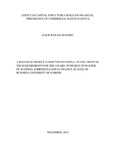| dc.description.abstract | A firm‘s capital structure consists of both debt (bonds) and equity (stock) and has been an
issue of great interest in the corporate finance literature. This is due to the fact that the mix
of funds (leverage ratio) affects the cost and availability of capital thus, firms‘ investment
source. Several theories from various scholars have been championed to explain the
corporate capital phenomena but somehow all seem unreasonable in the real world. The
most notable theory was that of Modigliani and Miller in the 1958‘s Capital irrelevancy
paper, ―under the perfect capital market assumption that if there is no bankrupt cost and
capital markets are frictionless, if without taxes, the firm‘s value is independent with the
structure of the capital‖. It is from the arguments of this paper that the researcher decided
to extend by examining the impact of capital structure choice on performance of
commercial banks in Kenya, covering five years from 2009 to 2013 by utilizing data of
banks from their annual financial reports. Multiple regression models was applied to
estimate the relationship between the capital structure and banking performance.
Performance was measured by returns on assets (ROA) and return on equity (ROE) while
determinants of capital structure which also served as independent variables included
reserve fund, long-term debt, short-term debt and customer deposits. The study revealed
that amongst the determinants of capital structure, capital reserve and long-term debts had
a strong positive relationship with ROE and ROA. Therefore, the researcher concluded
that there is no specific and perfect structure that would apply for all the commercial banks
in a uniform manner. This is because banks are at all-time at different levels of what they
hold as customer deposits, short-term debt, long-term debt and total capital reserves. | en_US |

